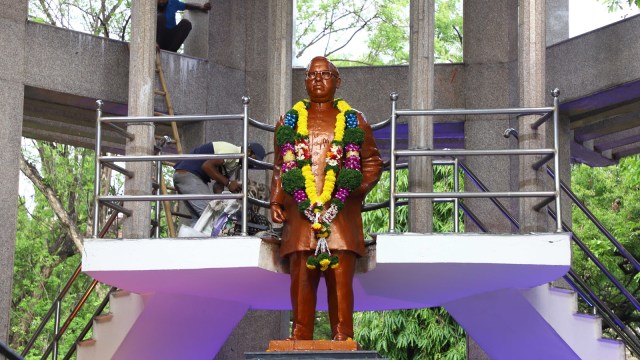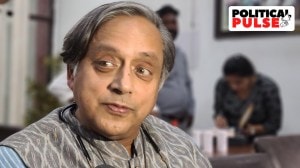- India
- International
Remembering the one and only Babasaheb Ambedkar
He authored the Preamble on February 6, 1948, with 81 words. In 1976, four words were added without deletion
 Spending three years at Columbia University, he completed 29 courses in economics, 11 in history, six in sociology, and five in philosophy, earning his MA and PhD in 1915 and 1916, respectively. (Express Photo)
Spending three years at Columbia University, he completed 29 courses in economics, 11 in history, six in sociology, and five in philosophy, earning his MA and PhD in 1915 and 1916, respectively. (Express Photo)Bhimrao Ramji Ambedkar (BRA) – jurist, social reformer, and chief architect of the Indian Constitution – was born on April 14, 1891. He was the 14th child, the last of his parents. This year for the first time in the history of UN, global leaders of 195 countries celebrated his birth anniversary for two days on April 18 and 23.
He suffered throughout his schooling from the curse of untouchability. After graduating, he was selected as a scholar to study in the US, which marked a turning point in his life. Spending three years at Columbia University, he completed 29 courses in economics, 11 in history, six in sociology, and five in philosophy, earning his MA and PhD in 1915 and 1916, respectively. He then continued his studies in London, where he was admitted to Gray’s Inn for Law and pursued a DSc at the LSE. Despite having to return to India, he later went to the UK, obtaining his Bar-at-Law and DSc degree. He also studied at Bonn University in Germany for a period.
During 1935-36, upon his return to India, he authored “Waiting for a Visa”, a 20-page autobiographical story reflecting his experiences with untouchability. The book is now a textbook at Columbia University. On January 12, 1953, Osmania University awarded him another doctorate.
The Mahad Satyagraha of 1927 marked a pivotal moment in Ambedkar’s political ideology. Leading a group of Dalits to drink water from Chavdar Lake, a public water source, he initiated the movement for Dalit emancipation. Ambedkar emphasised that their action wasn’t merely about drinking water, but about asserting their humanity and equality. This sentiment reverberates in Article 15 of the Constitution, which prohibits discrimination based on religion, race, or caste in the use of public wells, tanks, and bathing ghats. Possibly, nobody could have at that time thought that it would become part of the Constitution.
BRA is the father of the Constitution. Mahatma Gandhi had envisioned that the chief architect of the Indian Constitution should be a scholar from the depressed classes. Accordingly, he persuaded top leaders Jawaharlal Nehru and Sardar Patel to appoint Ambedkar as the chairman of the drafting committee. Ambedkar’s remarkable scholarship, erudition, intellectual prowess and extensive reading equipped him to navigate through various amendments proposed during the drafting process. When amendments were discussed in the Constituent Assembly (CA), Ambedkar eloquently articulated his viewpoints, persuading the Assembly while respecting the democratic process.

Among the seven original members of the drafting committee, a recent research by Aakash Singh Rathore in “Ambedkar’s Preamble” (2020) reveals that five had minimal involvement. The burden of drafting fell on Ambedkar, who authored the Preamble, born on February 6, 1948, with 81 words. In 1976, four words were added without deletion. The 75-year constitutional journey demonstrates the Preamble’s pivotal role as the lens through which the entire Constitution is interpreted, affirmed by constitutional courts as its integral and unalterable basic structure.
BRA’s DNA runs through the Preamble and the Constitution. In 1952, Columbia University conferred on him the degree of LL.D. This was in recognition of the work done by him as the chief architect of the Constitution.
BRA gave us the Indian-nized Constitution. Historian Granville Austin described our Constitution as the most progressive and revolutionary political document of the time.
Indians initially struggled to adhere to constitutional discipline, prompting Ambedkar to assert that adherence is paramount, regardless of a constitution’s quality. Deeply hurt, BRA said, burn the Constitution if you cannot follow it. He never wanted to burn it. It was a statement made in desperation. Crafting a constitution isn’t arduous, but its implementation demands seriousness, responsibility, and discipline. The story of 75 years of Indian Constitution is the story of protecting its basic structure. We will continue to be governed by the holy book. Let us look forward to the first centenary (2050) celebrations of the Constitution.
Just as I reflected on the youthfulness of the US Constitution in 1987 (even after 200 years of its creation in 1787), in 2050 we’ll marvel at the enduring vitality of the Indian Constitution. Constitutions, like plants, don’t age; they grow into trees, sustaining the nation. Ambedkar eventually resigned as India’s first law minister.
The Indian Parliament abandoned the comprehensive Hindu Code Bill, which included key provisions such as inheritance rights for women, mutual divorce rights for both genders, and remarriage rights for widows and divorcees. Ambedkar advocated for women’s rights, emphasising the importance of mutual respect and equality in marriage.
BRA was unique in different ways. His thinking. His vision. His statesmanship. How we wish he had lived longer.
(The writer is Professor Emeritus and former director of the National Judicial Academy)
Click here for real-time updates on the Lok Sabha 2024 Exit Poll results
Jun 02: Latest News
- 01
- 02
- 03
- 04
- 05





























